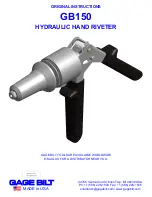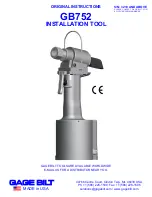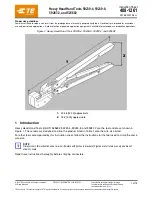
16C Low-Pressure Dead-Length Collet Blocks
Instructions B-145
Hardinge Inc. One Hardinge Drive, Elmira, New York U.S.A. 4902-507 800.843.880 (Canada 800.468.5946) www.hardingetooling.com
Par
t No
. B -0009500-0
45
6C Collet Block
Low-Pressure, Pneumatic or Hydraulic, Double Acting, Dead-Length
Part No. 7799-00-00-000096
Specifications
• Maximum unit operating pressure – 250 psi air, 2000 psi hydraulic
(17 bar air, 137 bar hydraulic)
• Draw tube force – 5.8 x line pressure
• Collet capacity – 16C {
1
/
64
" to 1
5
/
8
" (.39 to 41.27mm) round}
• Thru-hole in base
• Four 1/4-20 mounting holes in bottom of base
• Two
3
/
8
" (9.52mm) dowel holes in bottom of base
• Two
1
/
4
"-18NPT ports
• 2-position, 4-way control valve recommended for hydraulic operation,
2-position, 3-way control valve recommended for pneumatic operation (not included)
Safety
• Do not over tighten the mounting hardware or the plumbing fittings.
• When installing a collet in the closer, do not over tighten the collet.
•
Do not exceed maximum operating pressure of 250psi air or 207 psi hydraulic (7 bar air, 83 bar hydraulic).
• Make sure that the collet retains your material when the closer is closed.
Application
This 16C collet block is a stationary unit with a double-acting cylinder. It is effective on machine and assembly operations
that require reliable clamping and unclamping. Use the collet block as a single unit or mount multiple closers on rotary
tables, pallets, fixtures or tombstones for increased productivity.
Installation
1. Mount the collet block to a rigid flat surface.
2. Plumb your first supply line using 5000 psi (344 bar) rated steel tubing to the CLAMP 1/4 NPTF port of the
collet block and the normally OPEN 1/4 NPTF port of your control valve.
3. Plumb your second supply line using 5000 psi (344 bar) rated steel tubing to the UNCLAMP 1/4 NPTF port of
the collet block and the normally CLOSED 1/4 NPTF port of your control valve.
4. Plumb your control supply to the 1/4 NPTF pressure port of the valve.
5. This configuration maintains a closed collet until the valve is actuated.
Operation
1. Remove the supply from the valve.
2. Loosen the collet locking screw.
3. Insert the collet in the top of the collet block.






















